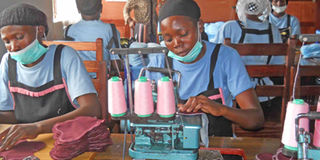When anything will do in place of a sanitary pad

Making the washable pads. Some girls up-country have to keep out of school during their menstrual period or resort to papers, mud or old clothes. Courtesy Photo.
What you need to know:
When you can afford to spend an average of Shs3,000 monthly on sanitary pads, you cannot even begin to conceive where you cannot access sanitary towels. Yet this is the reality for most adolescent girls upcountry who resort to mud, writes Grace Kenganzi.
When Sophia Klumpp and Paul Grinvalds came to Uganda in 2008 to work with a community organisation in Masaka, the last thing on their mind was menstrual kits. But after a year in a village in Buwama Sub -county, outside Masaka, it was all they could think about.
“We came to realise that school girls were staying away from school during menstruation. They could not afford disposable sanitary pads and so they used toilet paper, newspapers, old clothing, banana fibres and even in some areas, mud. These were very uncomfortable and not sustainable,” Klumpp narrated. “Then we thought of all the women in North America who use eco-friendly menstrual products as a way of addressing environmental concerns as well as health concerns since synthetic products sometimes harm people’s skin.” So they picked a leaf from this concept and designed similar products for girls.
They had the materials, equipment, and people willing to help them make the menstrual kits, but as Klumpp points out, “You can’t impose a product on a consumer; you have to make sure the consumer needs it and they show a willingness to buy.” So they carried out a one-year pilot study in 2009, based in a village in Masaka that had been their home.
“We had school girls coming for the products, and we got some publicity and that started attracting NGOs, head teachers, and we saw that there was a need in the market for a low cost menstrual product, and that we could fill this gap,” Klumpp says about the birth of the product. She says the product had three aspects to it: girls would not have to stay out of school during their period, it was logistically friendly since it was reusable, and it was environmentally friendly.
Soon, organisations with environmental conservation among their goals were partnering with them. “For instance, some of these companies had constructed latrines and these latrines needed constant emptying because girls were disposing sanitary products in them,” Grinvalds explains.
Clearly, there was need to increase production to meet the demand. And that is how Afripads, the company was started, in 2010. As is the case with business, the quality of the product is important, and Grinvalds says they carried out research about the best quality of material to use so that it would pass muster with the National Standards Bureau. In keeping with everything local, they moved around Kampala looking for the material they had chosen, in vain. Luckily, they found it in Kenya and went ahead to get it from there. Everything else used is Ugandan, something both Grinvalds and Klumpp are very proud of.
But the thing they are most proud of is being able to employ girls from the village, where the company started. They talk about the girls they started with during the pilot study and how it is them that make the company what it is. In fact, they decline to have their photos taken in their Bukoto office, and suggest that we go where the real work is done, the workshop in Masaka.




